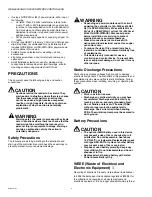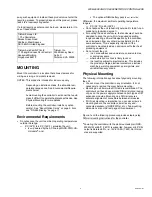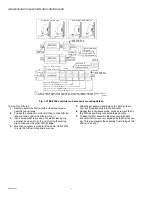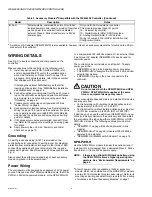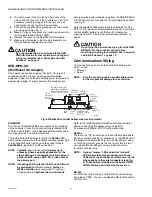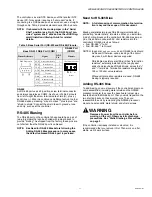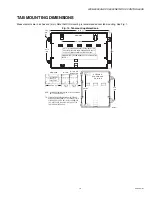
WEB-600E AND CP-600E NETWORK CONTROLLERS
11
62-0433—01
The controller is a serial DTE device, such that another DTE
device (PC, for example) requires a “null modem” cable. If
connecting to a DCE device such as a modem, use a straight-
through cable. Table 2 provides standard serial DB-9 pinouts.
NOTE: If rebooted with the mode jumper in the “Serial
Shell” position (see Fig. 3), the RS-232 port pro-
vides “system shell” access. See the
JACE Niag-
araAX Install and Startup Guide
for related
details.
.
RS-485
An RS-485 port uses a 3-position, screw terminal connector,
and always operates as COM2. As shown in Table 2 pinouts,
from left-to-right the screw terminals are shield (S), plus (+),
and minus (–). Wire in a continuous multidrop fashion to other
RS-485 devices, meaning “minus to minus,” “plus to plus,” and
“shield to shield.” Connect the shield to earth ground at one
end only, such as at the controller.
RS-485 Biasing
The RS-485 port on the controller’s base board has a pair of
two-pin jumpers that can be shorted with jumper blocks to
provide “biasing.” As shipped from the factory, these pins are
not shorted, thus the RS-485 port is unbiased.
NOTE: See Need for RS-485 Bias before following the
Adding RS-485 Bias procedure. In many cases,
the default unbiased RS-485 port is preferred.
Need for RS-485 Bias
NOTE: A full discussion of communication line termina-
tion is beyond the scope of this document.
Biasing sometimes improves RS-485 communications by
eliminating “indeterminate” idle states. When you install two,
2-pin shorting blocks on the controller’s RS-485 bias jumper
pins, this adds two onboard 3.3K ohm resistors into the
controller’s RS-485 circuit, as follows:
• from RS-485 “+” to 5V.
• from RS-485 “-” to Ground.
NOTES: In general,
only one device
on an RS-485 trunk should
be biased. Otherwise, undue loading of the circuit
may result, with fewer devices supported.
RS-485 bias resistors are
different
than “termination
resistors,” externally installed at the two physical
ends of a daisy-chained RS-485 trunk, across the “+”
and “–” terminals. Termination resistors are typically
100 or 120 ohm value resistors.
Whenever termination resistors are used, RS-485
biasing is typically required.
Adding RS-485 Bias
To add biasing, you must power off the controller and remove
some assemblies (including metal shield and the NPM6E
processor module) to access the base board jumper pins,
located behind the RS-485 port. Then you must reposition the
two shorting blocks on these jumper pins. Then you
reassemble the unit by remounting the NPM6E processor
module, hex standoffs, metal shield, and shield screws.
WARNING
Remove all power from the controller before
working on the unit. Observe static discharge
precautions. See “Static Discharge Precautions”
If the controller is already installed or mounted, it is
recommended that you remove it first. Then work on a flat,
stable, well-lit work surface.
Table 3. Base Serial Port (RS-232 and RS-485) Pinouts.
Base RS-232 DB-9 Port (COM1)
RS-485 Port
(COM2)
Pinout Reference
Signal
DB-9
Pin
Pinouts
DB-9 Plug (male)
DCD
Data carrier detect
1
3-Position connector
(male)
RXD
Receive data
2
TXD
Transmit data
3
DTR
Data terminal ready
4
GND
Ground
5
DSR
Data set ready
6
RTS
Request to send
7
CTS
Clear to send
8
not used on the JACE
9
S
–
+


